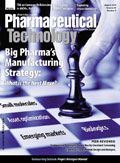A Commendable Cleanroom Compendium
The updated edition of William Whyte's book provides information for novices and seasoned professionals alike.
Cleanrooms are nearly ubiquitous in pharmaceutical manufacturing. Although the most widely discussed applications of cleanroom technology are the aseptic processing and testing of sterile products, they also are employed widely in the control of bioburden or particulate contamination. The prevalence of cleanrooms in healthcare product manufacturing and the regulatory emphasis placed upon them make a comprehensive text on the subject of cleanroom design, testing, and operation potentially valuable.
Despite being a rather succinct book, the new edition of Cleanroom Technology: Fundamentals of Design, Testing, and Operation does an outstanding job of covering a topic that is extremely important and often misunderstood. The author, William Whyte, is a well-known cleanroom expert, and the updated edition of his 2001 book manages to be authoritative and accessible at the same time. Because the book explains the basics of this topic, novices to the industry or to cleanrooms could benefit from it. That said, those with substantial background and experience in the discipline of contamination control also could learn from the book and, in all likelihood, would find themselves referring to it frequently.

Cleanroom Technology: Fundamentals of Design, Testing, and Operation, William Whyte, Wiley, Hoboken, NJ, 2nd ed., 2010, 384 pp., ISBN: 978-0470748060
Whyte has managed a truly comprehensive treatment of cleanrooms. He also provides a concise and entertaining history of cleanrooms, explains relevant international industrial and regulatory standards, and discusses cleanroom design, construction, cleaning, disinfection, monitoring, air-movement assessment, and the entry and exit of goods, equipment, and personnel.
In addition, Whyte describes separative technologies such as isolators, microenvironments, and restricted-access barrier systems. The inclusion of separative technologies in this book is essential because industry currently is implementing these technologies widely. Ultimately, they will replace the human-scale cleanroom for the most critical applications such as aseptic processing.
Pharmaceutical professionals might gain the most from Whyte's useful and informative description of gowning systems. Whyte pursues this topic in the context of a section about the central importance of managing personnel to mitigate contamination risk. The technical data he provides illustrates the true dimensions of the contamination contributed by humans, thereby highlighting the criticality of gowning and the value of highly disciplined operations. These passages read much like a technical summary of work that Whyte has done throughout his highly productive career and are replete with supporting data from the research that he and his colleagues have conducted.
In general, Whyte provides advice that is pragmatic and technically sound. The book is refreshingly free of absolutes. Whyte acknowledges that cleanrooms that are designed, maintained, and operated well do not support microbial survival. But he notes that the inevitable release of microbial contamination by operators makes periodic cleaning and disinfection necessary. Whyte never implies that the achievement of sterility in absolute terms in a cleanroom is a practical or reasonable expectation.
The subject of airflow visualization using smoke studies is highly emphasized, particularly in the United States. Whyte gives examples that underscore the value of airflow analysis, but provides a balanced perspective of smoke studies without the overemphasis on smoke testing common in industry and the regulatory community.
Whyte's near-equal emphasis on cleanroom recovery is significant. Given the data presented in the text regarding the potential for human -generated contamination in cleanrooms, recovery is in most respects more important than the rather subjective evaluation of smoke test results.
Whyte could have provided even greater benefit by pointing out clearly that all rooms rated Grade A or classified as ISO 5, for example, are not equivalent in their ability to recover from the introduction of contamination. The rapid dilution and removal of foreign matter and microbial contamination from cleanrooms is arguably the most vital aspect of truly excellent contamination-control performance.
Although the author included an entire chapter devoted to relevant sources of information, he unfortunately did not provide a bibliography of reference articles at the end of each chapter, which would have been useful.
The new edition of Whyte's book will prove a worthy addition to the literature about the design and operation of cleanrooms. The book is particularly well suited to generalists working in disciplines such as quality control, quality assurance, regulatory compliance, manufacturing operations, and validation who are responsible for cleanrooms. The book was clearly not intended to be an advanced text on the engineering of cleanrooms, but nevertheless, much information within its covers can benefit highly experienced engineers and scientists.
The book is clearly written, generally well-structured, and as a result is easy to read. Whyte has been among the most important individuals to the pharmaceutical industry in the areas of cleanroom design and contamination control. This text will ensure that his influence continues. Thoughtful readers will find fundamental information in this book that they will carry with them throughout their careers.
James E. Akers is the president of Akers Kennedy and Associates, PO Box 22562, Kansas City, MO 64113, akainckc@aol.com.

Drug Solutions Podcast: A Closer Look at mRNA in Oncology and Vaccines
April 30th 2024In this episode fo the Drug Solutions Podcast, etherna’s vice-president of Technology and Innovation, Stefaan De Koker, discusses the merits and challenges of using mRNA as the foundation for therapeutics in oncology as well as for vaccines.